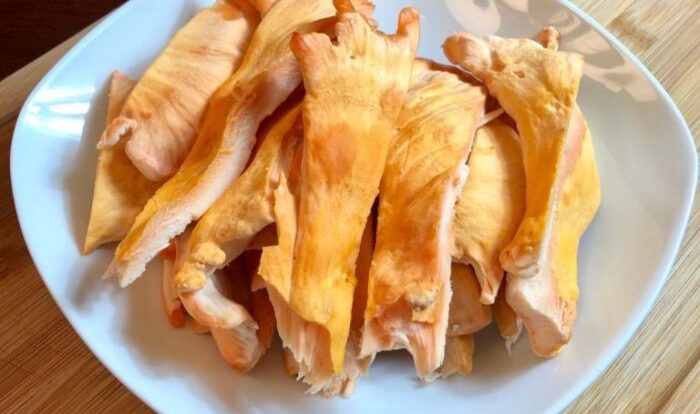
Embark on a culinary adventure with the chicken of the woods recipe, a delectable dish that not only tantalizes your taste buds but also nourishes your body with an array of essential nutrients.
This unique fungus, with its vibrant colors and meaty texture, has been a culinary staple for centuries, offering a versatile ingredient for soups, stews, stir-fries, and more.
Chicken of the Woods Identification and Safety
Chicken of the woods (COTW) is a distinctive and delicious edible mushroom found in forests worldwide. Its vibrant orange coloration and unique growth pattern make it easy to spot, but it’s crucial to properly identify COTW before consuming it to avoid potentially poisonous lookalikes.
Distinctive Characteristics of COTW
- Color:Bright orange, ranging from yellow-orange to deep orange-red.
- Shape:Large, shelf-like growth that forms on the sides of trees.
- Texture:Firm and meaty, with a slightly fibrous texture when cooked.
- Odor:Pleasant, fruity or slightly sour smell.
- Spores:White to cream-colored spores that can be seen on the underside of the mushroom.
Distinguishing COTW from Poisonous Lookalikes
Several poisonous mushrooms resemble COTW, making proper identification essential. Key differences to look for include:
- False Chicken of the Woods (Laetiporus sulphureus): Similar in color and shape, but has smaller pores and a more sulfurous odor.
- Jack-o’-Lantern Mushroom (Omphalotus illudens): Also orange, but glows in the dark and has gills instead of pores.
- Cinnabar Chanterelle (Cantharellus cinnabarinus): Smaller, with a more intense orange color and a distinctive funnel-shaped cap.
Importance of Proper Identification
Consuming poisonous mushrooms can lead to severe illness or even death. Always consult a field guide or expert before eating any wild mushrooms, especially if you’re not experienced in mushroom identification.
Nutritional Value and Health Benefits

Chicken of the Woods (COTW) is not only a culinary delight but also a nutritional powerhouse. Its unique composition offers a plethora of health benefits, making it a valuable addition to any balanced diet.
COTW is an excellent source of essential nutrients, including protein, fiber, vitamins, and minerals. It is particularly rich in antioxidants, which play a crucial role in protecting the body against oxidative damage and chronic diseases.
Antioxidants
- COTW contains a variety of antioxidants, including ergothioneine, which is a powerful antioxidant that has been shown to protect cells from damage caused by free radicals.
- Ergothioneine is also known to support immune function and reduce inflammation.
- Other antioxidants found in COTW include phenolic compounds, which have been linked to a reduced risk of heart disease and cancer.
Vitamins
- COTW is a good source of vitamin C, which is essential for immune function and collagen production.
- It also contains vitamin D, which is important for bone health and immune function.
- Additionally, COTW provides vitamin B vitamins, such as niacin and riboflavin, which are essential for energy production and nervous system function.
Minerals
- COTW is a rich source of potassium, which is important for regulating blood pressure and fluid balance.
- It also contains magnesium, which is essential for muscle function and nerve transmission.
- Additionally, COTW provides iron, which is necessary for oxygen transport and red blood cell production.
Culinary Applications: Chicken Of The Woods Recipe
Chicken of the Woods (COTW) is a versatile culinary mushroom that offers a range of cooking options. Whether sautéed, grilled, or roasted, COTW’s unique texture and savory flavor can enhance various dishes.
Craving a unique culinary experience? Try out the delectable chicken of the woods recipe , a foraged mushroom with a meaty texture and savory flavor. This edible fungus can be found in forests and parks, and its versatile nature allows for various cooking methods.
Whether you’re a seasoned chef or a curious foodie, the chicken of the woods recipe offers an exciting culinary adventure that will tantalize your taste buds.
COTW can be prepared in many ways, each showcasing its distinct culinary uses. Its meaty texture and umami-rich flavor make it a suitable substitute for chicken or other meats in vegetarian and vegan dishes.
Sautéing COTW
Sautéing COTW is a quick and easy method that brings out its savory flavors. Cut the mushroom into bite-sized pieces and sauté in a pan with butter or olive oil. Season with salt, pepper, and your favorite herbs and spices.
Sautéed COTW can be served as a side dish, added to pasta or rice dishes, or used as a topping for pizzas and salads.
Grilling COTW
Grilling COTW imparts a smoky, charred flavor. Brush the mushroom with olive oil and season it with your preferred spices. Grill over medium heat for 5-7 minutes per side, or until tender and slightly charred. Grilled COTW can be served as a main course with grilled vegetables or as a flavorful addition to burgers and sandwiches.
Roasting COTW
Roasting COTW brings out its earthy, nutty flavors. Toss the mushroom with olive oil, salt, and pepper. Roast in a preheated oven at 400°F (200°C) for 20-25 minutes, or until tender and browned. Roasted COTW can be used in soups, stews, casseroles, or as a flavorful side dish.
Storage and Preservation Techniques

Preserving the freshness and flavor of Chicken of the Woods (COTW) is crucial to enjoy its culinary delights. Whether you’ve foraged fresh COTW or purchased it from a market, proper storage and preservation techniques will extend its shelf life and maintain its nutritional value.
Refrigeration
- Fresh COTW can be stored in the refrigerator for up to 5 days. Wrap it loosely in a paper towel or place it in a perforated plastic bag to allow for air circulation.
- Avoid storing COTW in sealed plastic bags, as this can trap moisture and promote spoilage.
Freezing
- Freezing COTW is an excellent way to preserve it for extended periods. Cut the COTW into smaller pieces, blanch them for 2-3 minutes in boiling water, and then drain and cool them thoroughly.
- Place the blanched COTW in freezer-safe bags or containers and freeze for up to 6 months.
Drying, Chicken of the woods recipe
- Drying COTW is a traditional method of preservation that concentrates its flavors and extends its shelf life significantly.
- Slice the COTW thinly and arrange it on a drying rack or dehydrator. Dry at a low temperature (110-120°F) for several hours until crispy and brittle.
- Store dried COTW in airtight containers in a cool, dry place for up to 1 year.
Canning
- Canning COTW is a safe and effective method of preservation that allows for long-term storage.
- Prepare COTW by cleaning and cutting it into small pieces. Pack the pieces tightly into sterilized canning jars, leaving 1 inch of headspace.
- Fill the jars with a boiling water and vinegar solution, leaving 1/2 inch of headspace. Process the jars in a boiling water bath for 25 minutes for pints or 35 minutes for quarts.
Cultivation and Foraging

Chicken of the Woods (COTW) is a unique and flavorful mushroom that can be cultivated or foraged in the wild. Understanding its ideal growing conditions and proper foraging techniques is crucial for successful harvesting.
Ideal Growing Conditions
- Substrate:COTW grows on dead or decaying hardwood trees, particularly oaks, maples, and beeches.
- Temperature:Optimal temperatures for growth range from 55-75°F (13-24°C).
- Moisture:COTW requires a moist environment with high humidity.
- Sunlight:Indirect sunlight or partial shade provides the best conditions.
Foraging for COTW
When foraging for COTW, it’s important to be able to identify it accurately and ensure it’s safe to consume.
If you’re a fan of wild mushrooms, you’ll love the chicken of the woods. This mushroom is known for its unique flavor and texture that resembles chicken. You can find chicken of the woods recipes online or in cookbooks, and they’re relatively easy to make.
Just be sure to cook the mushrooms thoroughly to avoid any potential health risks.
- Identification:COTW has a bright orange to yellow color, with a velvety texture and a white or cream-colored underside.
- Safety:COTW is generally safe to eat, but it’s always recommended to have it identified by an experienced mushroom forager.
- Harvesting:Cut the mushroom close to the base of the trunk, leaving the base intact for future growth.
Environmental Impact and Sustainability
Cultivating and foraging for COTW can have environmental implications. Here are some considerations:
- Cultivation:Growing COTW requires substrate and controlled conditions, which can have environmental costs.
- Foraging:Over-harvesting or improper foraging practices can harm the ecosystem and deplete mushroom populations.
- Sustainability:Practicing sustainable foraging techniques and promoting responsible cultivation methods can help preserve COTW for future generations.
Ending Remarks
Whether you’re a seasoned forager or a curious home cook, the chicken of the woods recipe is an exciting opportunity to connect with nature and savor the flavors of the wild. So gather your ingredients, sharpen your knives, and let’s embark on this delicious journey together!
Answers to Common Questions
What are the key characteristics of chicken of the woods?
Chicken of the woods is known for its bright orange to yellow coloration, shelf-like shape, and meaty texture.
How can I distinguish chicken of the woods from poisonous lookalikes?
Look for the distinctive pores on the underside of the mushroom and avoid any specimens with gills or a slimy texture.
What are the health benefits of consuming chicken of the woods?
Chicken of the woods is a good source of antioxidants, vitamins, and minerals, including vitamin D, potassium, and fiber.





